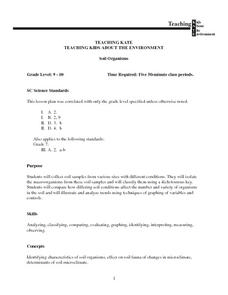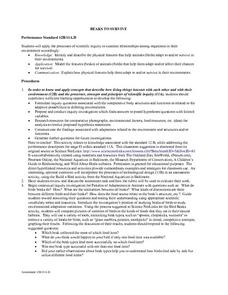Curated OER
How Do Living Things Form Communities?
In this communities worksheet, students will write down 1 main idea about communities formed by living things. Then students will brainstorm 3 details to support their main idea. This worksheet is a graphic organizer.
Curated OER
Super Scientists Code
For this science worksheet, students use the key code on the right to unscramble each of the scientists. They also match each of the scientists found to their correct description.
Curated OER
Classifying Living Things Wordsearch
In this biology worksheet, learners locate and identify various vocabulary terms related to classifying living things. There are 24 biology terms located in the word search.
Curated OER
Classification of Organisms
In this classification worksheet, students complete a crossword puzzle with 17 clues about vocabulary pertaining to the classification of organisms.
Curated OER
Classification of Organisms Crossword Answers
In this classification worksheet, students are provided with the answers to a crossword puzzle which has 17 clues pertaining to classification of organisms vocabulary.
Curated OER
Science: Putting Down Roots
Fourth graders, in small groups, observe plants and note their characteristics. After drawing pictures of the plants, including their roots systems, they hypothesize in which environments the plants would best thrive. Finally, 4th...
Curated OER
Ecosystems and Symbiotic Relationships
Students are told to create a community using words or pictures. They walk outside to an area in front of the school which has a strip of grass, ditch, and corn field. Students discuss the difference between an ecosystem and a...
Curated OER
Mussel Identification Activity
Young scholars identify given species of animals, such as various
mussels, by sets of physical characteristics as they use a key. They also read about mussels on the Illinois River and look at mussel species in the online database. ...
Curated OER
Food Webs
Students are explained that they are spending the next few days researching an organism in preparation for a field trip. They are shown an overhead of the Field Guide. Students discuss what habitat means. They use their organism to...
Curated OER
How to Keep Warm in the Arctic!
Pupils simulate the differences between animals protected by fat and those that aren't. They fill one of the mugs with shortening. Students cut a small hole, and place a thermometer in each piece of cardboard. They position the bulb of...
Curated OER
Identifying trophic levels and the skeletal system through Owl Pellets
Pupils identify a food chain sequence. They compare, identify, and record the rodent skeletal parts to a rodent skeletal diagram. Students construct a rodent skeleton from the skeletal parts found in the pellet. They are given the...
Curated OER
Is it Alive?
Students watch a demonstration using Duco glue and water and try to determine if the "monster" shown is alive. After the demonstration, they discuss what characteristics make an organism "alive". They participate in a card sorting...
Curated OER
SIM Ecosystem
Students identify and interpret the concept of an ecosystem and the potential impact humans have on ecosystems. They also proficient in organized and methodical Internet searches. Finally, students become proficient with public...
Curated OER
Activity 1: The Effect of Cold on Characteristics Important to Fishes
Students explore how organisms are adapted to live in the ultimate of extreme environments. They discuss the reasons for the similarities and differences between them, themselves, and the more familiar organisms around them. Students are...
Curated OER
Categorization
Second graders participate in a teacher led bead sorting activity in which they describe different ways the beads can be grouped. Next, they participate in activities in which they sort and resort themselves into groups according to...
Curated OER
"Endangered Species"
Students explore the definition of what an endangered or threatened species is and the criteria for a species being endangered or threatened. Many examples are shown and discussed with the students within this instructional activity. In...
Curated OER
Alien Invaders: Native vs. Exotic Species
Seventh graders investigate the differences between native and non-native species. They answer different level questions using Bloom's Taxonomy. This is done creatively with the students playing a version of the game Jeopardy. Students...
Curated OER
An Introduction to Brine Shrimp
Second graders engage in a instructional activity that seeks to discover information about Brine Shrimp. They conduct research using a variety of print and electronic resources. Students study the type of environment the shrimp need and...
Curated OER
Living Organisms
First graders investigate living things that are part of a class aquarium. They make observations and answer guided questions about each organism. Students read a Science textbook and engage in a class discussion about the content. Then...
Curated OER
Exploring Organisms
Students investigate various organisms in an attempt to understand the process of evolution and related ecological issues. This elementary activity uses small plastic animals and includes a worksheet for student assessment and reflection.
Curated OER
Soil Organisms
Students work together to collect soil samples from different locations. In the samples, they identify the macroorganisms and classify them. They identify the conditions that affect how macroorganisms grow. They also analyze and identify...
Curated OER
Science: Down Home Dinosaurs
students participate in hands-on activities to discover the different types of fossils. Using teacher-provided materials, they make models of cast and trace fossils. After writing essays describing how traces are formed, students plan a...
Curated OER
Beaks To Survive
Students discuss and identify the types of adaptations that are made by different organisms in order for them to survive. In groups, they describe the features of beaks and discuss how it affects their chances for survival. They share...
Curated OER
Coastal Biodiversity of South Africa
Learners investigate the biodiversity found along the coast of South Africa. They conduct research using a variety of resources. They use the information in order to write lab reports with the data. The lesson can be adapted to other...

























